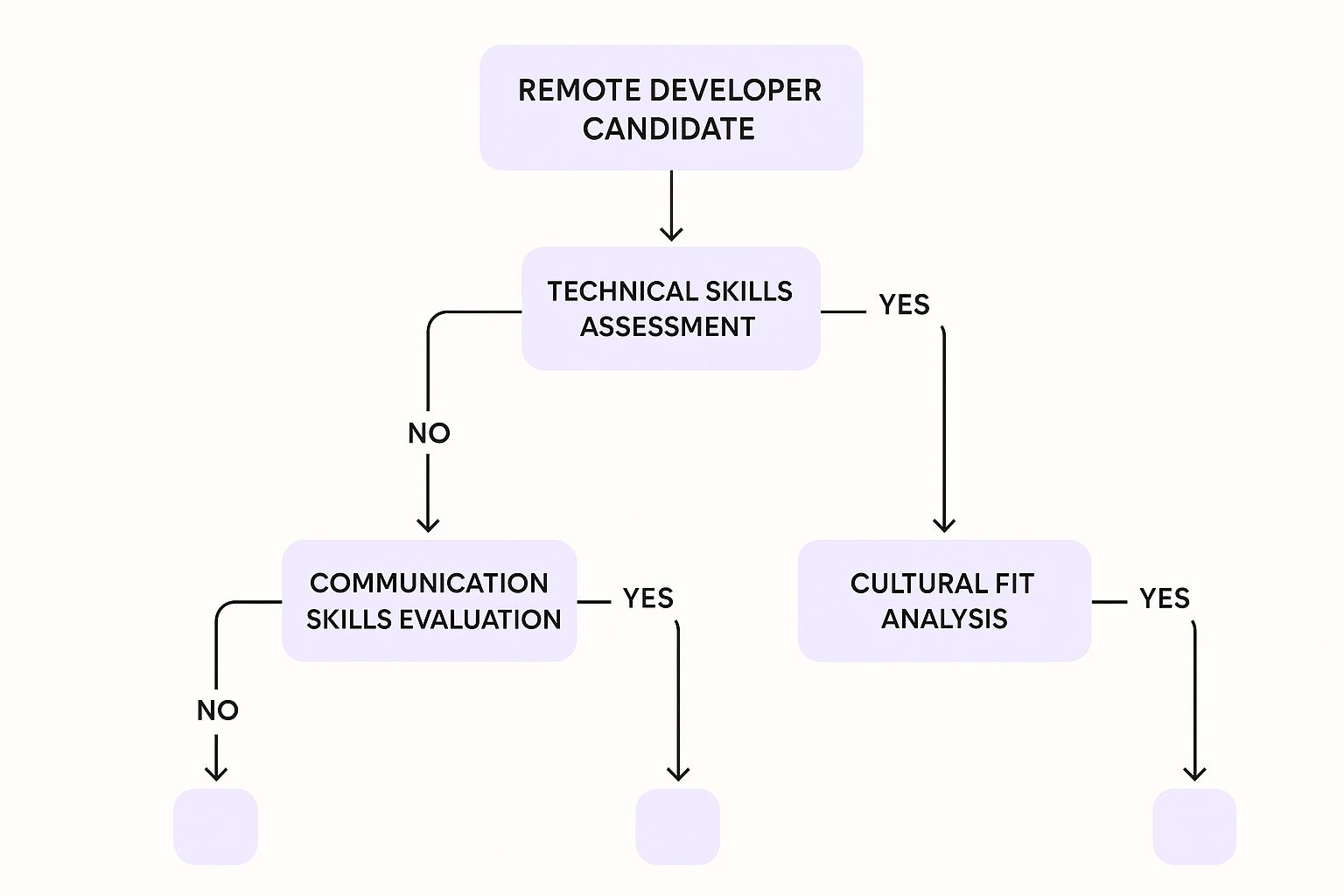
If you want to hire remote developers well, you can't just toss a job ad into the void and hope for the best. It takes a real strategy—one that covers everything from defining the role and sourcing talent globally to navigating international payroll and making sure your new hire feels like part of the team from day one.
The way companies build their tech teams has completely changed. Hiring remote developers isn't some temporary fix or a quirky trend anymore; it's a core business strategy for companies that want to innovate and grow. Those who get on board gain a massive competitive edge by breaking free from the limits of their local talent market.
And no, this isn't just about cutting down on office rent. It’s about tapping into a worldwide pool of specialized skills that might be impossible to find—or just way too expensive—in your own backyard.
Picture this: you desperately need a senior Go developer who knows their way around cloud infrastructure. It's a hot skillset. Your local market might have a handful of candidates, if you're lucky, leading to a long and costly search. But when you open that search to the world, you can find the perfect person faster and at a much more reasonable cost.
The global market for tech talent has never been more open. Tech hubs aren't just in Silicon Valley or New York anymore. They're popping up and thriving in places like Eastern Europe and Latin America.
Companies that look to these regions find more than just incredible talent; they find fresh perspectives that can spark real innovation. For example, knowing https://lathire.com/why-hiring-remote-workers-from-latam-is-a-smart-business-move/ gives you access to highly skilled pros who work in similar time zones.
The demand for remote developers has exploded, completely reshaping tech recruitment. A stunning 58% of developers now work fully remote, a massive jump from just a few years ago. Companies often save 30–50% on labor costs by hiring from emerging tech hubs instead of North America or Western Europe. Plus, remote-friendly companies enjoy 25% lower turnover rates than those forcing everyone back to the office.
The financial perks are a huge draw, but the strategic advantages go much deeper. When you have access to a global talent pool, you can build a team with diverse experiences and different ways of solving problems. This cognitive diversity is a secret weapon for boosting creativity and making your team more resilient.
Plus, remote work offers the flexibility that top developers now expect as standard. By offering it, you're not just attracting the best of the best—you're also more likely to keep them. While the move to remote is often about boosting output, optimizing productivity in a remote work environment does require a specific, thoughtful approach.
We've seen countless companies reap these rewards. Here’s a quick breakdown of why making this shift is such a smart move.
| Benefit Category | Key Advantage | Supporting Statistic |
|---|---|---|
| Talent Access | Tap into a worldwide pool of specialized skills, not just local options. | 58% of developers now work full-time remotely. |
| Cost Efficiency | Reduce labor costs significantly without sacrificing quality. | Companies report savings of 30–50% on labor costs. |
| Employee Retention | Attract and keep top talent by offering the flexibility they demand. | Remote-friendly companies have 25% lower turnover rates. |
| Innovation | Foster creativity and resilience with a team of diverse backgrounds. | Diverse teams are proven to be more innovative problem-solvers. |
Ultimately, building a successful remote team isn't something you do on a whim. It’s a deliberate move that turns hiring from a local headache into a global strategic advantage, letting you build a stronger, more capable team, no matter where they are.

Before you even think about where to find your next great hire, you need to get brutally honest about who you’re actually looking for. Posting a job ad for a “Python developer” is a surefire way to drown your inbox in irrelevant applications. It’s a recipe for a frustrating, time-consuming search that ends in a mediocre hire.
The first step when you hire remote developers is to move beyond a vague title and build a concrete profile. This isn't just about listing programming languages; it's about deeply understanding the role’s purpose, the skills needed to deliver, and the kind of person who will thrive on your team.
Start by asking a simple question: What is the core mission of this role? Will this person be building a brand-new feature from scratch, wrestling with legacy code, or leading a small project team? The answer completely changes the skills and experience you should be targeting.
Let’s get practical. Instead of a generic wishlist, think in terms of outcomes. What, specifically, will this developer accomplish in their first three to six months? This single question shifts your mindset from a checklist of skills to the real-world impact they’ll have on your business.
To build out your developer profile, focus on these key areas:
Technical Stack: Get specific. Don't just say "JavaScript." Name the frameworks and libraries they’ll live in, like React, Node.js, or Vue.js. Mention the exact database technologies (e.g., PostgreSQL, MongoDB) and any cloud platforms (AWS, Azure, GCP) they must be comfortable with.
Experience Level: This is so much more than "years of experience." A senior developer from a massive corporation brings a different skill set than a senior developer from a nimble startup. Be clear about the level of autonomy you expect. Do they need their hand held, or can they take an idea and run with it?
Project Scope: Is this a greenfield project (building from the ground up) or are they diving into a mature, complex codebase? The second scenario requires a knack for reading and understanding existing code, which is a skill all on its own.
Thinking through these details helps you craft a job description that works like a magnet for the right people and a filter for the wrong ones.
A classic mistake is creating a "unicorn" job description that lists every technology under the sun. This just scares away fantastic candidates who feel they don't tick 100% of the boxes, even if they're a perfect match for the core responsibilities. Be ruthless about separating the absolute must-haves from the nice-to-haves.
Technical chops are only half the story, especially in a remote team. I’ve seen brilliant coders grind entire projects to a halt because they couldn't communicate or collaborate effectively. When you hire remote developers, these "soft skills" are absolutely non-negotiable.
You need to define the personality and work style that will click with your company culture.
Key Soft Skills for Remote Success:
| Skill | Why It Matters for Remote Teams |
|---|---|
| Proactive Communication | In an async-first world, waiting for instructions is a bottleneck. You need people who share updates without being chased. |
| Problem Ownership | The best remote hires don't just flag problems; they dig in, propose solutions, and take the initiative to get things fixed. |
| Adaptability | Startups pivot. Project priorities change. A developer who embraces change is infinitely more valuable than one who is rigid. |
| Time Management | With no manager physically looking over their shoulder, a remote developer has to be disciplined and self-motivated to hit deadlines. |
Finally, your ideal candidate profile must be tethered to reality—your budget. A common pitfall is wanting a top-tier senior developer from Silicon Valley while offering a salary benchmarked against a completely different market. It just won’t work.
Global salary rates vary dramatically. A senior developer in Latin America will have a different market rate than one in Western Europe or North America. Do your homework. Research the going rates for the specific skills and experience you need in the regions you plan to hire from.
Being transparent and competitive with your compensation from day one sends a powerful signal. It shows you value talent and understand the global market, making your role far more attractive to the high-caliber developers you want to attract.

Finding great developers is one thing. Verifying their skills and making sure they'll actually thrive on your team is a completely different beast. When you hire remote developers, your sourcing strategy needs to cast a wide, intelligent net.
Forget generic job boards—they’re often a black hole of mismatched resumes. The real gems are usually found elsewhere.
Think about specialized remote job boards, vibrant global developer communities on platforms like GitHub or Dev.to, and niche talent networks. These are places where professionals who are already bought into the remote work model—and have the self-discipline it demands—tend to congregate. Don't just post a job and wait. You have to participate. Engage in discussions, contribute to open-source projects, and build a presence where top developers are already spending their time.
The best sourcing strategies are proactive, not passive. You can't just wait for the perfect candidate to fall into your lap. You need to go where they are.
Here are a few high-impact channels I’ve seen work time and again:
A common mistake I see is relying solely on LinkedIn. While it’s a useful tool, it’s also an incredibly crowded space. The most skilled and in-demand developers often aren't actively searching; they're discovered through their work and community contributions.
Once you have a pipeline of promising candidates, the real work begins. The goal of vetting isn't just to confirm technical skills; it's to assess problem-solving ability, communication style, and their fit for an asynchronous work environment. A resume simply can't show you that.
A multi-stage interview process is your best tool for uncovering this. It should be designed to test different facets of a candidate's abilities, giving you a holistic view of their potential. A solid flow might include an initial screening call, a practical technical assessment, a live coding challenge, and a final behavioral interview.
The take-home technical assessment is your first real glimpse into a candidate's hands-on skills. But you have to design it thoughtfully.
Please, avoid generic algorithm puzzles. Instead, create a small, self-contained task that mirrors the actual work they’d be doing. For a front-end developer, this could be building a small interactive component from a Figma design. For a back-end engineer, it might involve creating a simple API endpoint with specific requirements.
This approach tests several things at once:
A live coding session isn't about getting the "right" answer under pressure. It's about seeing how a candidate thinks. Give them a moderately complex problem and watch their process. Do they ask clarifying questions? Do they talk through their approach? Can they articulate trade-offs? This is where you test for collaboration and communication.
Finally, the behavioral interview ties it all together. Ask questions that reveal how they handle conflict, manage deadlines, and take ownership of their work. A great remote hire is a problem-owner, not just a task-doer.
The market for tech jobs is constantly shifting. While Python and JavaScript remain core skills, there has been a notable 47% year-over-year spike in Rust adoption. Go is also becoming key for cloud infrastructure, with demand outpacing available talent by roughly 3:1. Today, over 60% of new job postings for developers mention AI or machine learning skills, showing the rise of hybrid roles. Because of this, smart companies are prioritizing adaptability and learning velocity over rigid language checklists.
This holistic process ensures you’re not just hiring a resume, but a capable and collaborative professional who is ready to contribute from day one.
So, you’ve found and vetted the perfect remote developer. That's a huge win, but the work isn't over yet. Now comes the part that trips up a lot of companies: the administrative gauntlet of global payroll, contracts, and legal compliance.
Getting this wrong isn't just a minor hiccup. It can lead to some serious legal and financial pain down the road. How you tackle these complexities really boils down to your company's size, your appetite for risk, and your long-term vision for a global team.
Most companies go down one of two paths: hiring developers as independent contractors or partnering with a service called an Employer of Record (EOR).
This decision tree gives you a good starting point for thinking through the key criteria.

As you can see, a successful hire is a delicate balance of technical chops, communication skills, and how well they fit into your company’s culture.
Choosing the right way to classify and pay your international talent is probably the most critical decision you'll make at this stage. Each approach has its own set of pros and cons.
Here’s a breakdown to help you compare the most common employment models when you hire remote developers.
| Employment Model | Best For | Pros | Cons |
|---|---|---|---|
| Independent Contractor | Startups, short-term projects, or companies testing global hiring. | Fast setup, lower administrative burden, flexible contracts. | High risk of employee misclassification, limited control, no company-provided benefits. |
| Employer of Record (EOR) | Companies building long-term, distributed teams and prioritizing compliance. | Full legal compliance, handles payroll/taxes/benefits, reduces administrative overhead. | Higher cost than contractors, requires partnering with a third-party service. |
| Own Legal Entity | Large enterprises with a significant, long-term presence in a specific country. | Full control over all operations, can hire full-time employees directly. | Extremely expensive, slow to set up, requires deep local legal and HR expertise. |
Ultimately, the choice depends on your specific needs, but it's a decision with long-term consequences for your business.
This is the default for many startups and small businesses dipping their toes into the global talent pool. It’s undeniably faster and more flexible. You skip the headaches of local employment laws and payroll taxes. You just agree on a rate, sign a contract, and the developer sends you an invoice. Simple, right?
Well, that simplicity comes with a pretty big string attached: the risk of employee misclassification. If a tax authority decides your "contractor" is acting more like a full-time employee—based on how much control you have over their work, whether they work exclusively for you, and how integrated they are into your team—you could be hit with massive penalties, back taxes, and fines.
This is where an EOR comes in. An EOR service acts as the legal employer for your remote developer in their home country. They take care of all the messy but crucial parts of global employment:
Using an EOR dramatically cuts down your administrative load and legal risk. It’s the safer, more scalable choice for any company that's serious about building a sustainable distributed team.
An EOR lets you hire remote developers almost anywhere in the world without having to set up your own legal entity in every single country. It turns a massive legal challenge into a straightforward operational task, freeing you up to focus on building your team, not your legal department.
Whether you go with a contractor or an EOR, a rock-solid contract is non-negotiable. It needs to be legally sound in both your country and the developer's.
Your contract must clearly lay out:
To manage teams across borders effectively, a working knowledge of international business law is crucial for navigating different legal systems. This helps you create agreements that are both fair and enforceable.
Getting money to your international talent smoothly is another common operational hurdle. Currency conversions, transfer fees, and payment delays can create a lot of friction and frustration for your new hires.
For direct contractors, you might use wire transfers or platforms like Wise or PayPal, but these often have variable fees and add to your admin work. For companies hiring several remote workers, specialized payroll platforms are a much better solution. Our guide on payment solutions for remote workers in LATAM dives deeper into how to manage this well.
In the end, being proactive about payroll and compliance is a sign of a mature remote-first company. It shows you respect your global team members and are invested in building a sustainable, long-term relationship built on trust and security.

Even a star developer can stumble if their first few weeks are confusing and isolating. When you hire remote developers, a structured and welcoming onboarding process isn’t just a nice-to-have. It’s a critical investment that sets the tone for their entire time with your company.
A weak start leads to confusion, slow ramp-up times, and a sense of disconnection that’s hard to reverse. The real goal is to make your new team member feel supported, connected, and productive from their very first day, no matter what time zone they're in.
This process should kick off well before their official start date, with logistical preparations to ensure they can hit the ground running.
A smooth Day One actually starts with thoughtful preparation the week before. Your focus should be on getting all the administrative and technical pieces in place. This proactive approach shows you’re organized and that you value their time.
Your pre-onboarding should cover:
This initial effort prevents the frustratingly common experience of a new hire spending their first day just waiting for IT access.
The shift to remote work is here to stay. By 2025, an estimated 36.2 million American workers are expected to work remotely, an 87% jump from pre-pandemic levels. Globally, nearly 62% of companies plan to increase their remote workforce. Offering this flexibility makes it more likely employees will stick around. You can explore more data on remote work trends over on Apollotechnical.com.
The first week is all about integration. I'm not just talking about integrating into the codebase, but into the team’s culture and communication rhythms. A well-planned schedule of introductions and initial tasks helps them quickly find their footing.
A successful first week includes a blend of structured meetings and self-guided exploration. Instead of throwing them into a complex bug fix, start with smaller, well-defined tasks that let them get familiar with the development environment and deployment process.
For instance, a great first task might be fixing a low-priority bug, adding a tiny feature, or improving documentation. This gives them an early win and builds their confidence right out of the gate.
One of the most powerful onboarding tools I’ve seen is a clear 30-60-90 day plan. This document acts as a roadmap, outlining specific goals, learning objectives, and expected milestones for their first three months. It completely removes ambiguity and gives both you and the new hire a solid framework for measuring success.
Here's a simple way to structure it:
This plan gives your new hire a clear path from newcomer to confident contributor. For more tailored guidance, check out our guide on what to expect when onboarding remote employees from LATAM for region-specific insights.
Ultimately, a great onboarding process proves you’re invested in your new developer's success. It fosters a sense of belonging and sets the stage for a productive, long-term relationship.
When you start looking at global talent, a lot of questions pop up. It’s only natural. As you get ready to hire remote developers, you'll probably wonder about the day-to-day stuff, like juggling work schedules across continents or keeping your company’s data locked down. Let’s tackle the most common concerns.
The good news is, with the right approach and a few smart tools, these aren't just manageable challenges—they're opportunities. Great remote teams are built on a bedrock of clear communication, trust, and solid processes that address these issues from the get-go.
One of the first anxieties managers have when hiring remotely is the time zone puzzle. But here’s the secret: you don’t force everyone onto a single schedule. Instead, you get really good at asynchronous communication and find a sweet spot of overlap.
A super effective strategy is to set a few "collaboration hours." This is a 2-4 hour block where everyone, no matter their location, agrees to be online for real-time stuff like daily stand-ups or quick planning sessions.
For everything else, your team learns to lean on detailed documentation and crystal-clear communication in shared channels. Instead of a quick verbal tap on the shoulder, team members get in the habit of writing out their questions with full context in a tool like Slack or a project board like Jira. This not only creates a written record but also lets colleagues give thoughtful replies when their workday kicks off.
The biggest mistake you can make is trying to clone an in-office, 9-to-5 synchronous day across the globe. It’s a recipe for burnout and completely misses the point of hiring internationally. The real goal is to maximize deep, focused work while carving out key moments for the team to sync up.
You can't rely on random chats by the water cooler to build a strong culture with a distributed team. It takes real, intentional effort. You have to create those moments of connection.
Here are a few practical ideas that actually work:
Data security is a huge—and totally valid—concern when your team is scattered around the world. Protecting your IP and sensitive info isn't about one magic bullet; it's about a layered defense that blends tech, policy, and training. When you hire remote developers, a tough security posture isn't optional.
Your security plan needs several key pieces working together to create a safe environment for everyone.
Essential Security Measures:
| Security Layer | Actionable Steps | Why It's Important |
|---|---|---|
| Device Management | Issue company-owned laptops with pre-configured security software and enforce strong password rules. | This guarantees every device touching your network is up to snuff and gives you control over the hardware. |
| Network Security | Make a Virtual Private Network (VPN) mandatory for connecting to any company resources. | A VPN encrypts all data traffic, shielding it from prying eyes on unsecured networks like public Wi-Fi. |
| Access Control | Stick to the principle of least privilege. Developers get access only to the code and data they absolutely need. | This minimizes the potential fallout if an account ever gets compromised. |
| Regular Training | Run mandatory security awareness training on things like phishing scams, safe data handling, and password hygiene. | Your team is the first line of defense. People are often the weakest link, so keeping them sharp is critical. |
